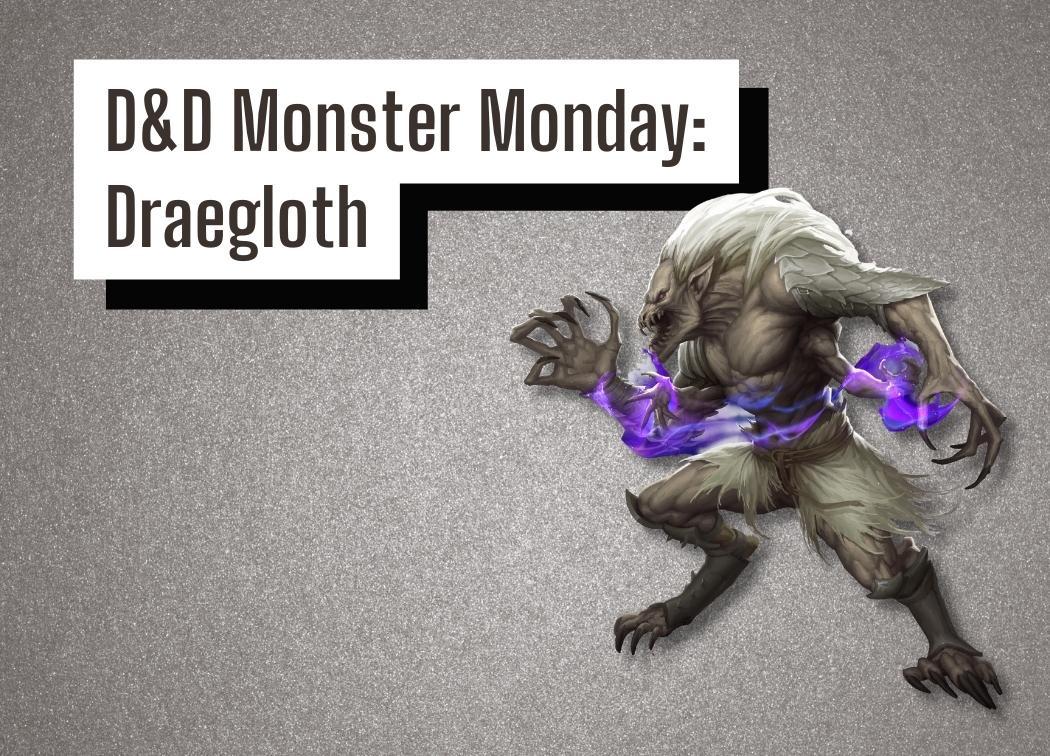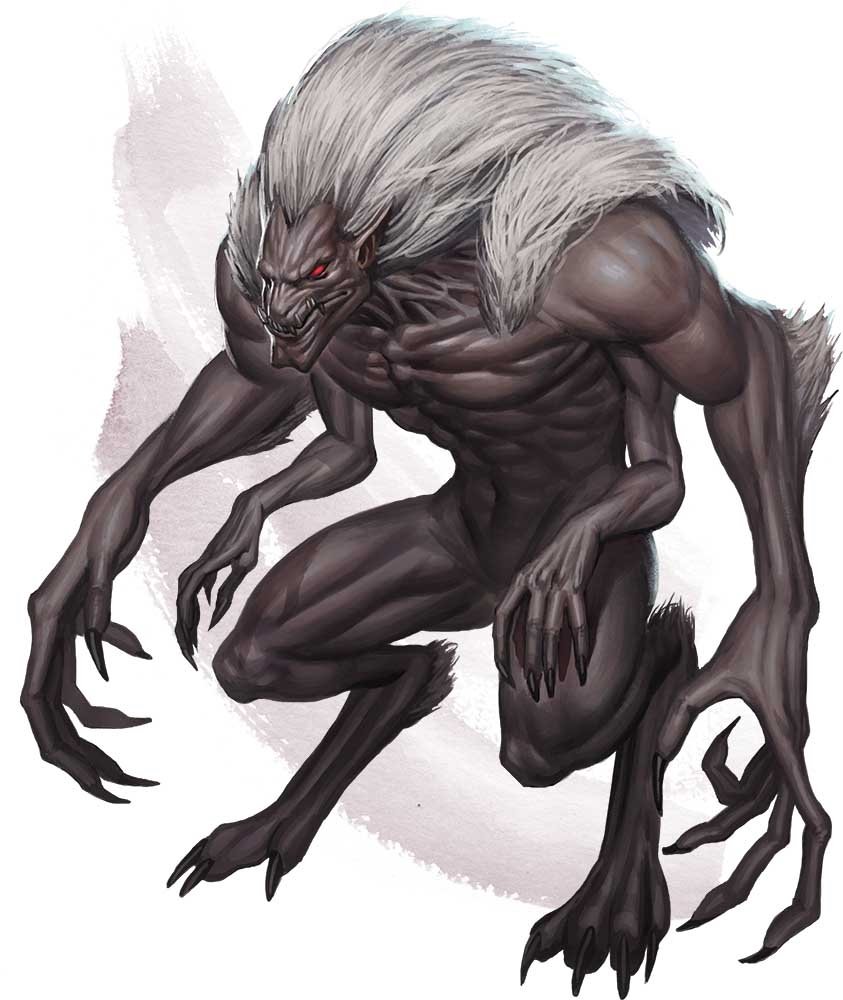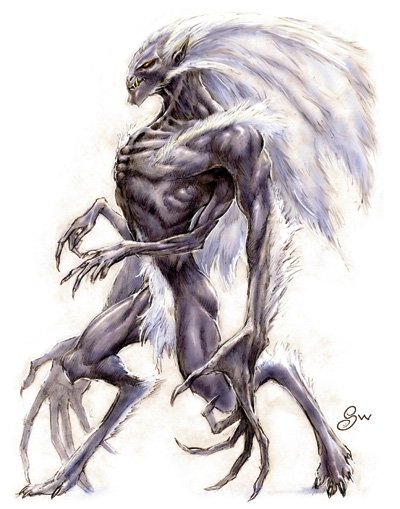D&D Monster Monday: Draegloth

This is usually the part of a Monster Monday article where I’ll write some fun flavor text about the creature. But today I need to ask what the fuck is with the drow and turning each other into monsters? The draegloth is just one in what feels like an ever-growing list of creatures that are created by a ritual involving Lolth.
I guess on the bright side draegloths are at least viewed as a gift from Lolth whereas being turned into a drider is a horrible punishment. They’re both treated poorly though so does that even matter in the end? Better question, why does anyone even follow Lolth if there’s even a chance you’ll be turned into a terrifying monstrosity or demon?
Drow society being unbelievably messed up aside, the draegloth is a great creature. They are a gifted melee bruiser-type creature, but they have some utility in the form of spellcasting to help them in a pinch. They’re also gifted assassins being surprisingly sneaky for a creature that’s “ogre-sized”!
Sure, I can understand why a drow house would want a child born as a draegloth, but it uh, doesn’t sound like a favorable deal for the child that’s turned into a draegloth. Let’s crack open Volo’s Guide to Monsters and dive, yet again, into the despicable parts of drow society.

Draegloth Lore
A draegloth is the combination of a drow and a glabrezu demon. This isn’t a natural birth or anything like that, though. It’s part of a ritual that involves a high priestess of Lolth giving birth to a draegloth after a successful ritual.
That being said, it’s extremely rare for this ritual to succeed. Only the most devout, most worthy of Lolth’s priestesses can birth a draegloth. Once the ritual has succeeded, the draegloth stays in the service of the birth mother’s house.
Draegloths are treated like top tier servants, favored slaves, or like a consort of the priestess that birthed them. So they’re not as poorly treated as quaggoths but they’ll never garner the respect and status of a typical drow of that house.
Although a draegloth is regarded as one of their houses most deadly and important weapons. When drow houses fight with each other the house with a draegloth has an enormous advantage over the other(s). Most houses with a draegloth will even create their plans with the draegloth being the centerpiece of the entire operation.
Draegloths are anything but stupid. They’re at least of average intelligence, but their predatory instincts certainly get the better of them. They love nothing more than to rip an opponent limb-from-limb and are super impatient when it comes to in-depth tactics and planning.
Draegloth Stats and Abilities
You can find the draegloth’s statblock on page 141 of Volo’s Guide to Monsters.
Stats
Size: Large fiend (demon)
AC: 15 (natural armor)
HP: 123 (13d10 + 52)
Speed: 30 ft.
STR: 20 (+5)
DEX: 15 (+2)
CON: 18 (+4)
INT: 13 (+1)
WIS: 11 (+0)
CHA: 11 (+0)
Now, this is an ability score array! We’ve got exceptional Strength and Constitution and a decent amount of Dexterity, all three of which will be regularly utilized by the draegloth in melee combat. Not to mention that means that we’ve got at least a +2 in 2 of the 3 most commonly used saving throw abilities.
Even the draegloth’s worst ability scores aren’t even that bad with the lowest to rolling in at +0 modifiers. Sure, that’s not great, but I’d take a +5 and +4 with no negatives in my statblock any day.
15 AC isn’t amazing, but it’s not terrible either. Most adventurers in appropriately-balanced combat with a CR 7 creature will be able to hit that AC more often than not. However, they won’t be able to chew through 123 HP easily, especially when the target has four damage resistances/immunities!
Resistances, Immunities, Saves, and Skills
Skills: Perception +3, Stealth +5
Damage Resistances: cold, fire, lightning
Damage Immunities: poison
Condition Immunities: poisoned
Senses: darkvision 120 ft., passive Perception 13
Languages: Abyssal, Elvish, Undercommon
CR: 7 (2,900 XP)
A passive Perception of 13 is solid for a creature with a +0 to Wisdom so let’s take what we can get in that regard. A +5 to Stealth checks, though is great. They’re relatively light-footed for such a large creature meaning that you can play a draegloth as either a frontline bruiser or a quiet assassin. They’re quite flexible!
Draegloths are blessed with some fantastic damage resistances and immunities. They have resistance or immunity to three of the most common damage types, plus resistance to lightning damage which isn’t anything to scoff at either when there’s a good chance they’ll be up against spellcasters with Lightning Bolt.
Of course, immunity to poison damage always comes with immunity to the poisoned condition.
We also should not be surprised about their 120 ft. of darkvision, though they seemed to have avoided the Sunlight Sensitivity that drow and driders have.
Honestly, CR 7 may be a bit low for this creature. You’ll see in a little bit, but they dish-out some hefty damage. Pair that with their fantastic defenses in the form of resistances, traits, immunities, and high HP and you have an absolute wrecking ball.
Abilities and Traits
Fey Ancestry. The draegloth has advantage on saving throws against being charmed, and magic can’t put it to sleep.
Innate Spellcasting. The draegloth’s innate spellcasting ability is Charisma (spell save DC 11). The draegloth can innately cast the following spells, requiring no material components:
At will: darkness
1/day each: confusion, dancing lights, faerie fire
Fey Ancestry is a very cut-and-dry benefit to the draegloth’s statblock. Fewer spells and effects that can CC a creature is always a boon!
As was with the drider, the draegloth didn’t lose this trait from being morphed into a drow-demon hybrid.
I’ve mentioned the draegloth’s spellcasting a few times now. It’s a nice add-on but it’s certainly not a major feature of their kit in my opinion. This is because the draegloth’s spell save DC of 11 is pretty god-awful for a CR 7 creature.
There’s an extremely high chance that the player character you target will be able to succeed on a saving throw making spells like Confusion and Faerie Fire Hail Marys rather than reliable crowd control or utility.
However, being able to cast Darkness at-will makes up for this in my opinion. Use it to obscure yourself so you can rush closer to enemy ranged attackers as they shoot at you with disadvantage. Use it to obscure yourself to run away from a life-threatening scenario. You can even use it to force your prey to move out of their current position.
At-will Darkness is an exceptional tool and there are tons of ways to use it to the draegloth’s advantage.
Actions
Multiattack. The draegloth makes three attacks: one with its bite and two with its claws.
Bite. Melee Weapon Attack: +8 to hit, reach 5 ft., one creature. Hit: 16 (2d10 + 5) piercing damage.
Claws. Melee Weapon Attack: +8 to hit, reach 10 ft., one target. Hit 16 (2d10 + 5) slashing damage.
With a three-attack Mutiattack on the board, you know I’m going to bring up the action economy value that this brings to the table. Seriously though, this equates to 48 damage between three attacks.
Also, there are two different damage types in the mix, but because it’s piercing and slashing damage, there won’t be tons of opportunities for this to make much of a difference. A creature or character that has resistance to one generally has resistance to both.
Claws also has a reach of 10 ft. unlike its Bite counterpart. Keep in mind that this is a large-size creature as well so the radius for opportunity attacks is nothing to scoff at. Tread carefully if you engage a draegloth in melee combat!
Draegloth Strengths
Well-Equipped to Survive
A draegloth’s damage is already close to (if not already) above average for a melee CR 7 creature in my opinion. You’d, therefore, expect their survivability to be average at best in this scenario.
Nope, not even close. They are absolute tanks!
15 AC isn’t amazing for their CR, but it’s still enough to ensure that not every single attack will hit. Especially when they can toss a Darkness on themselves for defensive measures as they move closer to the party.
123 HP is already quite an impressive health pool, but when you add the fact that they have resistance/immunity to have three extremely common damage types that health pool becomes spectacular.
Fey Ancestry is yet another great addition to the draegloth’s survivability toolkit. Especially since with their +0 modifiers to Charisma and Wisdom charms would typically give them a difficult time. These are not going to be an easy creature to crowd control!
All in all, the draegloth statblock has an answer to some portions of every style of combat. They are well-equipped to succeed in a fight against your adventuring party, it’s just up to you to use them well!
Utility and Stealth
Typically I’d be hyped to play a creature with a free cast of Confusion and Faerie Fire, but unfortunately, due to the draegloth’s DC 11 spell save these are typically going to be used as last resorts rather than reliable utility and crowd control.
Dancing Lights isn’t a terrible pick-up either, though. Remember, a creature having darkvision means that they can see in the dark, but in pitch-black darkness, they roll Perception checks at disadvantage. Dancing Lights can give a draegloth an edge at searching for a hidden target if the party tries to sneak past one.
While draegloths are large creature, they’re also as graceful and quiet as a drow. They make excellent assassins thanks to their +5 to Stealth checks. Not only that, but they can throw out an at-will Darkness to aid them in sneaking up on a target, or to avoid being spotted by a group of guards.
They have some interesting tools, and while their spell save DC is low, they at least have some options other than “run up and hit that target”.
Tons of Damage!
Draegloths can do, on average, 48 damage per turn with their Multiattack. That’s not bad for a single action in combat. Especially since two of those three attacks can be made with a reach of 10 ft.
Keep in mind too that each of these attacks are made with a +8 to hit so there’s a favorable chance that any target without high AC will be bearing the brunt of these attacks. Even then, draegloths still have a solid chance of hitting even well-armored characters and creatures!
Their attacks aren’t particularly flashy, but they do get the job done.
Draegloth Weaknesses
Susceptible to Ranged Attackers
Thankfully for your party, the draegloth statblock does have one glaring weakness. That is, of course, that they don’t have any ranged attack options. They’re a melee-focused creature so surely this isn’t surprising, but it’s still a weakness nonetheless.
They also only have 30 ft. of speed per turn meaning that they can’t naturally outpace a typical medium-size adventurer without needing to utilize a Dash action.
The combination of at-will Darkness and the 10 ft. reach of Claws does help mitigate the party’s ranged attackers’ attempts at kiting a draegloth. However, they still don’t have any direct answers to ranged attacks.

How to Play a Draegloth
Corner Your Foes and Use Darkness to Safely Advance
While they are quite hardy creatures, draegloth can still be peppered with ranged attacks from a resourceful spellcaster or archer. Therefore, when you’re designing an encounter with draegloth(s) in it, you should give them a chance to back their prey into a corner!
Draegloth will work well if they, or the creatures they’re working with, can corral the party into a corner and keep them there. This way the draegloths will know exactly where to advance and can safely use Darkness on themselves to bolster their defenses against direct attacks.
Keep in mind that the draegloth can’t see when they’re surrounded by magical darkness, so this does require the draegloth to be certain that they have the party trapped before they just blindly rush toward the party.
Oh, don’t be afraid to add some rocks, furniture, etc. to the battlefield for the draegloth to duck behind for cover either! It may slow down your advance, but the bonus armor you’ll gain may be a worthwhile trade-off depending on the situation, especially if you can combo it with Darkness.
This is also a solid plan for retreating from a fight. If shit hits the fan, cast Darkness on yourself and rush to the nearest exit!
Rip, Rake, and Tear!
Chances are your DC 11 spell saves won’t be much of a threat, so try your damndest to get into melee range of some creature and use your Multiattack combo. Keep in mind that two of the three attacks can be made at a 10 ft. range.
Draegloths are intelligent creatures. They can distinguish the difference between an easy and difficult target to hit so if they can attack a poorly-armored target they’re going to take that opportunity.
However, their inherent bloodlust is one aspect of their lore you should keep in mind during combat. They’re going to try to attack whenever they get the chance. They’ll try to preserve themselves as best as they can, but otherwise, they’re going to be heavily trending toward laying a smackdown on their foes.
5 Draegloth Plot Hooks
- The Dark Ritual – A drow house is conducting a ritual to create a draegloth. Rumor has it, they’ll probably succeed in doing so. Stop them before they unleash this demonic abomination in the city!
- Quelling an Insurrection – House Ilvalrius’ draegloth convinced their quaggoth to revolt against the household. The fools. Their house is done for, but please clean up the remaining forces so that this doesn’t impact the lives of innocents.
- Procuring the Artifact – It is rumored that Lolth desires a gemstone found deep within the Underdark. A household looking to perform the ritual to create a draegloth believes that including this in the ritual will ensure their success. They’re willing to pay handsomly for this artifact.
- Prevent an Assassination – The houses are at war again, as usual. Our leadership has been targeted by an enemy house. If you’re willing to protect them, we’re willing to make it worth your time.
- Werewolf? – There have been multiple murders in the high elf city of Eilnafar. They appear to be the work of a pack of werewolves, but strangely enough, no one has found the culprit and there hasn’t even been a full moon yet! Mysterious indeed.
Conclusions
I love the aesthetic of the Underdark. It’s a fun place to run a campaign or story arc in for sure. Draegloths are a new addition to this that I’m itching to include next time my party delves deep under the surface.
The draegloth is a surprisingly flexible creature. They can switch between a light-footed assassin and hulkish behemoth at a moments notice and can fulfill both roles successfully. It’s not difficult to think up an encounter where at least one draegloth could be included.
Their lore is fun too. Well, fun for everyone but the unlucky drow that got turned into a draegloth, but still. As a DM you can come up with plenty of ways to include one. Honestly, it was tough to limit myself to five for this article!
I swear next Monster Monday I’ll pick something from somewhere outside of the Underdark, but this one was just too fun to pass up!
